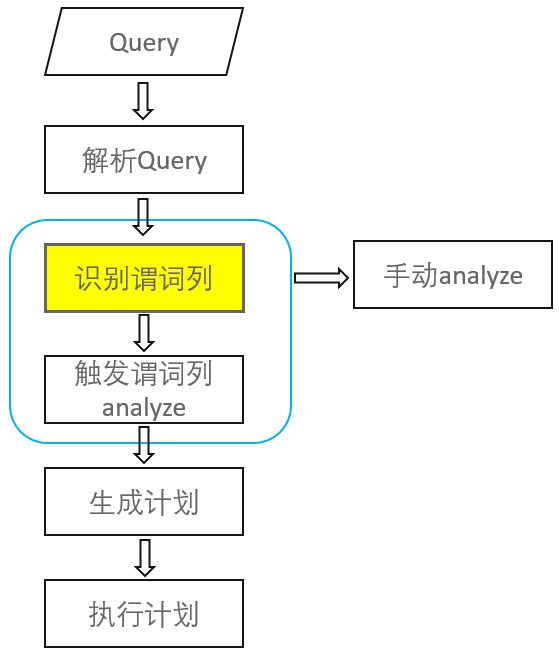本文分享自华为云社区《GaussDB(DWS) 谓词列analyze揭秘》,作者:SmithCoder。
1. 前言
适用版本:【9.1.0.100(及以上)】
当前 GaussDB(DWS)中存在手动 analyze,查询触发的动态 analyze,以及后台线程的轮询 analyze 三种触发形式,其中动态 analyze 又分为 light 模式和 normal 模式,light 模式是基于内存存储统计信息,normal 模式是存储在系统表里,前者较为轻量,对目标表仅加一级锁。这些 analyze 默认都是对表全列进行采样,尤其对于大宽表 analyze,耗时会比较久,其实很多时候计划生成所需的统计信息列只占一部分,如果只对这部分列进行采样计算,将会大大节省 analyze 的时间。因此 GaussDB(DWS)引入了谓词列 analyze。
2.原理介绍
analyze 的时候主要耗时在采样数据,对于非定长列如 varchar,其统计信息的计算也耗时,耗时肯定随着表的列数增加而变长。谓词列 analyze 会在查询阶段对谓词列进行识别收集,当触发动态 analyze,会只选择采样谓词列,手动谓词列 analyze 也会只采样谓词列部分。
谓词列通指于 WHERE 条件,join 条件,group by 中涉及到的列,更广义的是指所有需要用于计划生成需要统计信息列的列。
识别到的谓词列包含:
如比较(=,>,<),like, between,is,in, having,join on,MERGE on 后面的列
如 group by, order by, distinct, over partition/order by 列,union /minus 列
等值条件列为一个子查询,子查询的对应的输出列;
cte 中的一个列被外层引用为谓词列;
视图中的列被外层应用为谓词列;
agg 列
列建立了索引,相应的列也会被收集识别
如果表建立了 hash 分别列,分布列也收集识别
3.使用介绍
下面分别介绍谓词列 analyze 支持两种形式:
动态采样谓词列 analyze
手动谓词列 analyze
3.1 谓词列的 guc 控制
谓词列 analyze 的开启由 guc 参数 analyze_predicate_column_threshold 控制
参数说明:控制是否开启谓词列 ANALYZE 及限定支持的最小列数。该参数仅 9.1.0.100 及以上集群版本支持。
参数类型:SIGHUP
取值范围:整型,0~10000
默认值:10
3.2.动态采样谓词列 analyze
前提:动态采样谓词列 analyze 只支持 light 模式
查询的时候会进行谓词列的识别,如果有新的谓词列或者修改计数达到,则会触发动态采样,会把新识别的和已有的谓词列进行采样计算 统计信息。
下面是按照 analyze_predicate_column_threshold=1 举例,计划中 RunTime Analyze Information 部分会打印出 analyze 的表和列信息。
create table t1(a int, b int, c int);create table t2(a int, b int, c int);set enable_fast_query_shipping=off;set autoanalyze_mode=light;-- 首次会收集所有列的统计信息test=# explain select * from t1; QUERY PLAN ------------------------------------------------------------------------------------------------------------------------------- id | operation | E-rows | E-memory | E-width | E-costs ----+------------------------------+--------+----------+---------+--------- 1 | -> Streaming (type: GATHER) | 20 | | 12 | 16.10 2 | -> Seq Scan on t1 | 20 | 1MB | 12 | 10.10 RunTime Analyze Information ------------------------------------------------------------------------------------------------------------------------------ light runtime analyze on "public.t1" times:9.245ms, stats:sync, change:0(0 in xact), alive:0.000000, threshold:50.000000 ====== Query Summary ===== ------------------------------- System available mem: 4710400KB Query Max mem: 4710400KB Query estimated mem: 1024KB insert into t1 select generate_series(1, 100), 1; -- 修改计数达到,收集到了a,b两个谓词列,触发动态采样 test=# explain select * from t1 where a=b; QUERY PLAN -------------------------------------------------------------------------------------------------------------------------------- id | operation | E-rows | E-memory | E-width | E-costs ----+------------------------------+--------+----------+---------+--------- 1 | -> Streaming (type: GATHER) | 1 | | 12 | 7.62 2 | -> Seq Scan on t1 | 1 | 1MB | 12 | 1.62 RunTime Analyze Information ------------------------------------------------------------------------------------------------------------------------------- light runtime analyze on "public.t1(a,b)" times:9.774ms, stats:sync, change:100(0 in xact), alive:100.000000, threshold:50 Predicate Information (identified by plan id) --------------------------------------------- 2 --Seq Scan on t1 Filter: (a = b) ====== Query Summary ===== ------------------------------- System available mem: 4710400KB Query Max mem: 4710400KB Query estimated mem: 1024KB(19 rows)
-- 修改计数达到后查询,查询下面的语句,会分别收集表t1,t2对应的谓词列test=# explain select t1.* from t1 join t2 on t1.b=t2.c where t1.a=t2.a; QUERY PLAN -------------------------------------------------------------------------------------------------------------------------------- id | operation | E-rows | E-memory | E-width | E-costs ----+--------------------------------------+--------+----------+---------+--------- 1 | -> Streaming (type: GATHER) | 2 | | 12 | 21.55 2 | -> Hash Join (3,5) | 2 | 1MB | 12 | 15.55 3 | -> Streaming(type: BROADCAST) | 400 | 2MB | 8 | 10.93 4 | -> Seq Scan on t2 | 200 | 1MB | 8 | 2.00 5 | -> Hash | 200 | 16MB | 12 | 2.00 6 | -> Seq Scan on t1 | 200 | 1MB | 12 | 2.00 RunTime Analyze Information ------------------------------------------------------------------------------------------------------------------------------- light runtime analyze on "public.t1(a,b)" times:11.031ms, stats:sync, change:100(0 in xact), alive:200.000000, threshold:60 light runtime analyze on "public.t2(a,c)" times:8.571ms, stats:sync, change:100(0 in xact), alive:200.000000, threshold:60 Predicate Information (identified by plan id) ---------------------------------------------------- 2 --Hash Join (3,5) Hash Cond: ((t2.c = t1.b) AND (t2.a = t1.a)) ====== Query Summary ===== ------------------------------- System available mem: 4710400KB Query Max mem: 4710400KB Query estimated mem: 4388KB
-- 遇到新的谓词列且该列没有统计信息也会触发 test=# explain select * from t1 where c=1; QUERY PLAN -------------------------------------------------------------------------------------------------------------------------------- id | operation | E-rows | E-memory | E-width | E-costs ----+------------------------------+--------+----------+---------+--------- 1 | -> Streaming (type: GATHER) | 1 | | 12 | 8.25 2 | -> Seq Scan on t1 | 1 | 1MB | 12 | 2.25 RunTime Analyze Information ------------------------------------------------------------------------------------------------------------------------------- light runtime analyze on "public.t1(a,b,c)" times:10.063ms, stats:sync, change:0(0 in xact), alive:200.000000, threshold:70
复制代码
3.3 手动谓词列
语法:analyze (predicate) tablename;
执行后,只会对当前为止收集到的谓词列进行采样,最后在查询业务稳定后使用;
3.4 谓词列管理
通过函数 pg_stat_get_predicate_columns 可以查询当前表有哪些谓词列
test=# select pr.attnum,pa.attname from pg_catalog.pg_stat_get_predicate_columns('t1'::regclass) pr left join pg_attribute pa on pa.attrelid='t1'::regclass and pa.attnum = pr.attnum; attnum | attname --------+--------- 1 | a 2 | b(2 rows)
复制代码
通过函数 select * from pg_catalog.pg_stat_get_predicate_columns(‘t1_3’::regclass);可以清空表的谓词列,一般用于谓词列太多或者过期的情况去清空重建
4.总结
9.1.0.100 版本中 autoanalyze(light 模式)和谓词列默认是开启的,用户无需感知。对于频繁大量更新和查询场景,此前的动态采样可能会耗时,影响查询业务,新增谓词列后会减少 analyze 的耗时,特别对大宽表场景耗时优化是可观的。
5. 参考文档
一文读懂 analyze 使用【这次高斯不是数学家】 https://bbs.huaweicloud.com/blogs/354294
一文读懂 autoanalyze 使用【这次高斯不是数学家】 https://bbs.huaweicloud.com/blogs/354298
华为开发者空间,汇聚鸿蒙、昇腾、鲲鹏、GaussDB、欧拉等各项根技术的开发资源及工具,致力于为每位开发者提供一台云主机、一套开发工具及云上存储空间,让开发者基于华为根生态创新。点击链接,免费领取您的专属云主机。
点击关注,第一时间了解华为云新鲜技术~












评论